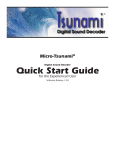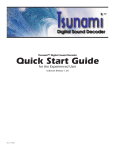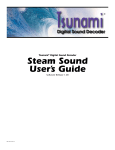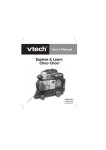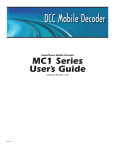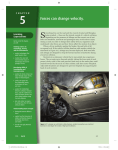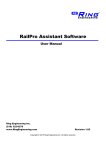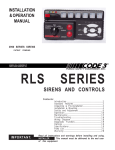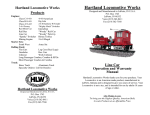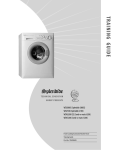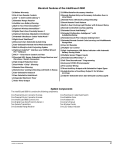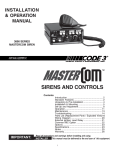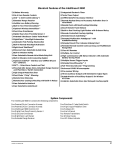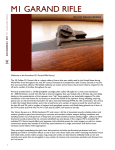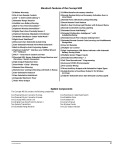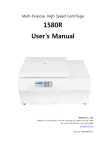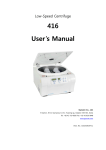Download Tsunami SoundCar User`s Guide
Transcript
® SoundCar ™ Digital Sound Decoder™ Tsunami Digital Sound Decoder SoundCar User’s Guide Software Release 1.01 Rev. B 11/4/14 Notice The information in this document is subject to change without notice. SoundTraxx (Throttle Up!) shall not be liable for technical or editorial errors or omissions contained herein; nor for incidental or consequential damages resulting from the furnishing, performance or use of this material. This document contains information protected by copyright. No part of this document may be photocopied or reproduced in any form without the prior written consent of Throttle Up! Corp. Product names mentioned herein may be trademarks and/or registered trademarks of their respective companies. SoundTraxx, Tsunami, SoundTraxx DCC, Digital Sound Decoder, Dynamic Digital Exhaust, Auto-Exhaust, Hyperlight, CurrentKeeper, Intelligent Consisting, and SoundCar are trademarks of Throttle Up! Corp. Table of Contents All Aboard!............................................................................................1 Overview.................................................................................................................1 Operation...............................................................................................2 Using Your SoundCar Digital Sound Decoder........................................................2 Basics of Programming.......................................................................5 Programming Procedure........................................................................................5 Basic Programming............................................................................11 Step 1: Configuring the Address...........................................................................11 Step 2: Configuring the Decoder..........................................................................12 Step 3: Function Mapping.....................................................................................14 Step 4: Configuring the Lighting Outputs..............................................................17 Step 5: Setting the Momentum.............................................................................22 Sound Programming..........................................................................23 Step 6: Modifying Sound Effects..........................................................................23 Consist Programming........................................................................30 Step 7: Consist Operations . ................................................................................30 Miscellaneous Features.....................................................................35 Step 8: Configuring the SoundCar’s Miscellaneous Features..............................35 Troubleshooting.................................................................................39 Appendix A..........................................................................................41 Appendix B..........................................................................................42 Appendix C..........................................................................................43 Appendix D..........................................................................................44 Table Directory Table A. Whistle Signals....................................................................3 Table B. CV 29 – Configuration Register 1.....................................12 Table C. Quick Reference for CV 29 Values...................................13 Table D. SoundCar Function Mapping Table...................................14 Table E. Hyperlight Control Mode Settings.....................................19 Table F. Sound Mixer CVs...............................................................24 Table G. CV 115 – Airhorn/Whistle Select.......................................24 Table H. CV 227 – Bell Select.........................................................25 Table I. CV 117 – Rolling Stock Type Select...................................28 Table J. CV 21 – Consist Function Control Group 1.......................32 Table K. CV 22 – Consist Function Control Group 2.......................33 Table L. Automatic Sound Function Enable....................................36 Table M. CV 13 – Analog Function Enable 1..................................38 Table N. CV 14 – Analog Function Enable 2...................................38 All Aboard! Overview Congratulations on the purchase of your SoundTraxx® Tsunami® SoundCar™ Digital Sound Decoder™ (DSD). This User’s Guide will walk you through the various aspects of programming your SoundCar DSD, as well as provide some tips for troubleshooting. For advanced programming techniques, refer to the Tsunami SoundCar Technical Reference, which provides a comprehensive list of CVs available for use with the SoundCar, including a description of the exact function and make‑up of each CV. Technical Bulletins and Application Notes covering various topics are also published periodically, and can be downloaded for free from our website at www.soundtraxx.com. Tsunami SoundCar User’s Guide Page 1 Operation Using Your SoundCar Digital Sound Decoder Now your train doesn’t have to be limited to locomotive sounds! The 16‑bit SoundCar DSD is the only DCC decoder to replicate railcar sounds like the clickety‑clack, generator, brake cylinders, and more. The SoundCar DSD uses sounds recorded from actual trains. Whether you want to include cab cars, freight cars, reefers, passenger cars, or a caboose (or all!) in your train, the SoundCar can reproduce the prototypical sounds appropriate to each car. Your SoundCar DSD has been shipped with all CVs pre‑programmed so you can begin using it immediately without having to make adjustments. The SoundCar lets you use the function keys to re‑create the sounds of typical actions that a train crew performs during operation, while incorporating automated sequences for other prototypical train sounds like the clickety‑clack, flat spots, flange squeals, and wheel noise. Additionally, certain related sounds, such as brake set up, application and release, are grouped together and controlled by a single function key. Note: Pay careful attention to the installation instructions and follow the recommendation on the placement of the decoder in your model so that the Intelligent Consisting sensor is easily accessible. Default function assignments are as follows: Function Key F0 F1 F2 F3 F4 F5 F6 F7 F8 F9 F10 F11 F12 Effect Headlight On/Off Bell Airhorn/Whistle Short Airhorn/Whistle Unassigned FX5 Function Output FX6 Function Output Dimmer Audio Mute (4x Intelligent Consisting Enable) Generator Uncoupling and Glad Hand Release Apply/Release Brakes Coupler Clank Although it’s not technically a function key, the emergency stop button also activates the sound effect of the air being dumped from the brake line. While these are the default settings, you may make changes to the function mapping later. For now, set your controller to address 3, place the SoundCar-equipped model on the mainline, and start toggling through the available functions to activate the effects. Turn On the Lights Press F0 on your cab to turn on the headlight of a cab car. Reverse the direction and the headlight turns off as the backup light turns on. While waiting on a siding, press F7 to dim the headlight for an oncoming train. Tsunami SoundCar User’s Guide Page 2 Operation If you have wired the FX5 and FX6 function outputs for Hyperlight lighting effects, pressing F5 or F6 will activate your selected effects. You can use those outputs to incorporate lighting into the interiors of your cab cars and passenger cars. Ring the Bell Engineers are required to ring the bell during yard movement. To ring the bell, press F1 on your cab. This is an on/off function, i.e., once activated, the bell will continue to ring until you press F1 again to turn it off. Blow the Horn/Whistle Engineers are required to blow various signals to warn of approaching trains, as well as to notify passengers and train crew to the planned movement of the locomotive. There are signals for crossings, stopping, moving forward, backing up, and more. Learning and using airhorn/whistle signals can add a lot of fun to your operating sessions. Some of the more common signals are indicated in Table A. To activate the airhorn or whistle, press F2 on your cab; the longer you press the key, the longer the sound will play. While this feature allows you to make long or short signals, F3 is designated as a “short” horn so those signals will have that nice, crisp “toot” regardless of how responsive your cab controls may be. Table A. Whistle Signals Note: = Short Blast — = Long Blast ——— Approaching grade crossing. (Hold final blast until crossing is occupied.) — Flagman protect rear. Brakes applied. —— Release brakes, proceed forward. When stopped, back up; when moving, stop. Request signal from trainman. — Warning signal (used when approaching areas with obstructed views, approaching passenger or freight trains, and passing freight trains). Start the Generator By default, F9 controls the generator effect. While still in the railyard, a crew member turns the generator on before the train leaves the station. The generator will run automatically until shut off at its final destination. You can re‑create this scenario by setting the generator sound effect to play automatically. In the “Sound Programming” section of this guide, we will discuss how to configure the generator sound effect for prototypical operation in refrigerator and passenger cars. Tsunami SoundCar User’s Guide Page 3 Operation Activating Other Functions and Effects Depending on the number of function keys on your cab, you may have additional functions available to activate. Mute the Sound As with all SoundTraxx DSDs, pressing F8 will mute all sound effects – great for when you need to take a quick break from the sounds of your layout. Pressing F8 a second time will turn the sounds back on. Brake Squeal/Release The sound of squealing brakes are typically heard when the train line has a brake set applied. Pressing F11 while the train is moving will initiate the brake set, which includes the sounds of the brake cylinder being set up and the brake shoes squealing as they make contact with the wheels. Press F11 again and the car will respond by producing the sounds of the retainer valve and bleed‑off as the brakes are released. The brakes can also be set and released when the train is idle using F11 – perfect for performing a standing brake test prior to departure. Turn F11 on to hear the brakes set up and then turn F11 off to release and hear the retainer bleed off. Since F11 also controls the brakes in Tsunami DSDs, you can sync up the braking effects of Tsunami‑equipped engines with SoundCar‑equipped rolling stock. See “Miscellaneous Features” for more information on F11 braking and CVs 3, 4 and 61. Coupler Clank Press F12 to activate the sound effect of the coupler engaging. Press F10 to listen to the knuckle opening and the glad hands separating as the coupler is released. See how well you can time these sound effects to the actual coupling and uncoupling of your cars to the train! Emergency Stop Pressing the emergency stop button will play the sound of the air being dumped from the emergency stop valve (also known as the “big hole” application) to lock up the brakes. Automated Sound Effects Give your fingers a rest and let the SoundCar take over with automated sound effects. Your decoder is defaulted to automatically play the clickety‑clack and flange squeals in response to the throttle speed. Give them a listen by increasing the throttle on your cab. Other sound effects, such as the generator, bell and airhorn, can be programmed to turn on and off automatically. Refer to the “Sound Programming” section for details on setting up automated sound effects. Tsunami SoundCar User’s Guide Page 4 Basics of Programming Programming Procedure Because each DCC system is unique, the procedure for programming a Configuration Variable (CV) differs among systems. Unfortunately, we cannot provide detailed instructions to cover every available command station and must assume that you have some level of understanding regarding the capabilities and operating procedures specific to your system. For detailed programming procedures, please consult your DCC system manual or contact the manufacturer for support. What is a CV? Configuration Variable (CV) is the industry‑adopted term for a decoder’s user‑programmable memory locations. CVs allow you to customize individual decoder properties such as the address, volume, sound effects, lighting, and much more. Once a CV has been programmed, the setting will be permanently remembered even after the power is turned off. A CV can be modified as often as necessary by simply reprogramming it with a new value. With the large number of CVs available, first inspection of the available options may cause confusion and even a little panic. Relax! As previously indicated, the DSD has been shipped with all CVs pre‑programmed so you can begin using your SoundCar immediately without making adjustments. The following sections break out the SoundCar’s CVs into various categories, so it is only necessary to change a few CVs at a time if you want customized operation. As you become comfortable with one set of CVs, move on to a new category and begin exploring the available options and capabilities. Detailed information related to any CV can be found in the Tsunami SoundCar Technical Reference. Bits and Bytes One of the most confusing aspects of programming a CV is figuring out the meaning of all the different bits, bytes and x’s found in various decoder manuals. This problem is further compounded by differences in each command station manufacturer’s user interface. If just reading about bits and bytes already has your head spinning, a short math lesson is in order before proceeding (but don’t worry, there won’t be a test). Each CV stores a numeric value that can be represented in one of the following three forms: Decimal – This is the most common and familiar numbering format, and the one that most of us use in day‑to‑day life. Numbers are represented as a sequence of digits comprising the numerals 0, 1, 2, 3, 4, 5, 6, 7, 8, and 9. Hexadecimal – Also referred to as simply “hex,” this is a specialized number representation that uses the characters A‑F in addition to numerals 0‑9. An advantage of hexadecimal numbering is that it allows a given decimal number to be more compactly represented. For example, the decimal number Tsunami SoundCar User’s Guide Page 5 Basics of Programming 127 converts to a simple 7F in hex. If your command station’s interface allows a limited number of digits, hex numbering can allow your cab to display a greater range of numbers. Binary – Binary numbers get their name from the fact that they only use two digits, 0 and 1, which are called “bits.” Binary is the fundamental numbering system used by computers, including those found inside a digital decoder. Because there are only two bit values, more digits are required to represent a number when using binary. For example, the decimal number 127 is written as 01111111 in binary notation. A “byte” is a binary number made up of eight bits, and a “nibble” is one‑half of one byte, or four bits. Each CV is made up of one byte (i.e., eight bits) and can store any number from 0 to 255. Most CVs contain a single piece of data that can be easily represented in any of the three number formats described above. For example, CV 3 (Baseline Acceleration Rate) can be loaded with any value from 0 to 255 and it will always and only affect one thing – the acceleration. Now, a little more about those bits: Some CVs use the individual bits to control various features. This keeps the number of CVs more manageable and allows up to eight distinct features to be controlled using a single CV. Bit variables require binary input and will only respond to input values of 0 and 1. For this reason, programming by the bits is usually reserved for simple variables that are either ON or OFF, disabled or enabled, etc. Unfortunately, bit variables are difficult to represent in any form other than binary while still preserving their meaning. As most DCC system user interfaces don’t use binary representation, programming by the bits using binary requires a little bit of math (just simple addition though!) to convert values into the decimal or hex representations used by most DCC systems. To facilitate programming, we have tried to use decimal representation in this manual when defining advisable values to program into a given CV; however, you will occasionally find binary values listed in the Tsunami SoundCar Technical Reference. Now, let’s try a programming example for CV 29 (Configuration Register 1), which works best when programmed by the bits. When programming individual bits, we suggest the following procedure to determine the correct decimal value. Referring to the CV description in the Tsunami SoundCar Technical Reference, write down the value that will produce the desired response for each bit. In this example, we want to program this CV so that speed tables and 28 speed-step mode are enabled. As indicated in the technical reference, bits 1 and 4 should both be set to 1 to enable the desired features, with all of the other bits set to 0. Write down the individual bit values as shown below: bit 7 Tsunami SoundCar User’s Guide bit 6 bit 5 bit 4 bit 3 bit 2 bit 1 bit 0 Page 6 Basics of Programming We then look up the binary value determined above, 00010010, in Appendix A and see that it corresponds to a decimal value of 18 (or hex value of 0x12). Program the decimal value (18) into the CV to get the desired response. If you don’t have the conversion chart available, or just feel compelled to do some calculations in your free time, the CV value can be determined by an alternate method. Reading from right to left in the figure below, there is a decimal value associated with each bit, beginning with 1 and doubling in value for each successive bit (i.e., bit 0 = 1, bit 1 = 2, bit 2 = 4, bit 3 = 8, bit 4 = 16, bit 5 = 32, bit 6 = 64, and bit 7 = 128). The decimal value associated with each bit is only counted when that bit is set to 1. As reflected in the figure below, bit 1 has a value of 2 and bit 4 has a value of 16. Adding these two numbers together gives the correct decimal value of 18. bit 7 When bit is set to 1, value = Therefore: bit 6 128 0 bit 5 64 + 0 bit 4 32 + 0 bit 3 16 + 16 bit 2 8 + 0 bit 1 4 + 0 bit 0 2 + 2 1 + 0 = 18 Programming Methods There are two methods for programming CVs in your SoundCar DSD. Operations Mode Programming – Sometimes called “Ops Mode” or “programming on the main,” this programming mode allows CVs to be changed while the car is operating on the layout, even when other locomotives and rolling stock are present. The ability to program during operation greatly enhances your ability to re‑create prototypical scenarios; for example, you can increase the momentum of a locomotive after it couples to a train. One disadvantage of Ops Mode programming is that CV data cannot be read back to verify values. To confirm the value of a CV that is programmed in Operations Mode, the SoundCar DSD will audibly verify that it is properly responding to your programmer by producing a short cowbell sound effect when a command is received. Service Mode Programming – This programming mode usually requires connecting the car to a dedicated programmer or placing it on a special programming track. SoundTraxx offers an advanced line of DSDs that support the following four types of Service Mode instructions: • Address Mode – Only CV 1 (Primary Address) may be changed. • Register Mode – Only CVs 1, 2, 3, 4, 7, 8, and 29 may be changed. • Paged Mode – Uses a page register to indirectly modify any CV. • Direct Mode – Allows you to directly change any CV. Tsunami SoundCar User’s Guide Page 7 Basics of Programming Reading CVs Certain command stations permit you to read the value of a CV and verify its setting in Service Mode programming. If you have trouble reading or verifying CVs, the problem may exist in the design of your command station and not in the decoder itself. Decoders of all types and brands communicate back to the command station using something called an acknowledgment pulse, which is defined in NMRA S‑9.2.3 as “an increased load on the programming track of at least 60mA for at least 6ms ±1ms.” Your SoundCar DSD allows you to read back CVs on the programming track by showing the value on the screen of your command station to indicate an acknowledgement. If you experience difficulties while programming and/or reading CVs, try a different programming mode. If your DCC system supports it, the best way to program CVs is in Operations Mode, as it allows you to immediately see or hear the results of your changes. It is important, however, to realize that not all programming modes will work with all CVs. Ultimately, the programming modes you will use depend on the type of DCC system you are using. Many of the newer DCC systems can automatically select the appropriate programming mode, so all you need to do is specify the CV number and desired value. On the other hand, some DCC systems only support certain programming modes and may restrict which CVs you can program. When in doubt, refer to your DCC system’s manual or contact the manufacturer to determine which programming modes they support. Note: The SoundCar does not require a programming booster, such as the PTB-100. Locking and Unlocking CVs CV Lock/Unlock is a feature that allows you to program a decoder without the danger of overwriting the programming in another decoder, which is especially useful when you have multiple units in a consist equipped with SoundCar decoders. This feature is controlled by the following CVs: CV 15, CV Unlock Code CV 16, CV Lock ID CV 30, Error Information/Alternate Mode Selection Note: Locking the decoder will not affect its ability to be added to a consist using Intelligent Consisting, which is discussed in the “Consist Operations” section of this document. Before using the CV lock feature available in CVs 15 and 16, bit 0 of CV 30 (Error Information/Alternate Mode Selection) must be set to 1 (the default value is 0). This ensures that you will not inadvertently lock the decoder when the CV lock feature is not needed. CVs 15 and 16 are used to lock and unlock your SoundCar DSD. CV 15 contains the unlock code and may be programmed with any value from 0 to 255, regardless of whether the decoder is locked or unlocked. CV 16 contains the lock code and may be set to any value from 0 to 7, but only when the decoder is unlocked. Attempts to program CV 16 with a value greater than 7 will be ignored. Tsunami SoundCar User’s Guide Page 8 Basics of Programming The decoder is unlocked when the value in CV 15 matches the value in CV 16. Otherwise, the decoder is locked and cannot be reprogrammed in either Operations Mode or Service Mode. Moreover, a locked decoder cannot be reset to its factory defaults until it is unlocked. SoundTraxx decoders are shipped from the factory with all CVs unlocked (CVs 15 and 16 are both set to 0). Note: If the decoder is unlocked, changing the value in CV 16 will instantly lock the decoder. You must then set CV 15 to the value programmed into CV 16 to unlock the decoder again. If you decide to use the CV locking feature for a multi‑decoder installation, you must first set the lock code in CV 16 in each decoder prior to installing the next one. Otherwise, all of the decoders will have the same lock code and the lock/unlock feature will not work. To ensure the lock/unlock feature will work correctly in a multi‑decoder installation, install one decoder and program its lock code. After you have locked the first decoder, install the second decoder and set its lock code. Because the first decoder is locked, it will be unaffected while you program the second decoder (unless you happen to accidentally set the lock code of the two decoders to the same value. If this happens, disconnect the second decoder and start over). Repeat this procedure until all decoders have been installed and their respective lock codes set. It is a good idea to create a system to help you remember all those lock codes. As an easy example, you might choose to set the lock code for motor decoders to 1, sound decoders to 2, and function decoders to 3. In any event, keeping CV 15 set to 0 will guarantee that the decoder stays locked until you are ready to program. If You Forget the Lock Code As there are only eight possible combinations, you can easily determine a forgotten lock code using trial and error with the following procedure: Place the model on the programming track and set CV 15 to 0. Then, try to read the value programmed into CV 16. If CV 16 does not read back, the decoder is locked. Set CV 15 to 1 and try reading CV 16 once more. Again, if CV 16 does not read back, the decoder is locked. Program CV 15 to 2 and try reading CV 16 again. Continuing in this manner, you should eventually find the value programmed into CV 16, as it can only be a value from 0 to 7. If you have set CV 15 to all eight values from 0 to 7 and the decoder still does not respond, there may be a problem with the installation, the programming track, or even the decoder itself. Investigate further and contact SoundTraxx customer support as necessary. If you do not have access to a programming track with read‑back capabilities (or are uncertain if yours is working properly), you can also use Operations Mode to determine the lock code. To do this, alternately program CV 15 and another CV to a value where there is a known response. For example, changing CV 128 (Master Volume Control) should produce audible feedback Tsunami SoundCar User’s Guide Page 9 Basics of Programming via a change in sound level if the decoder is unlocked. Begin by setting CV 15 to 0 and CV 128 to 0. If the volume level does not fall to 0, the decoder is locked. Next, set CV 15 to 1 and reprogram CV 128 to 0. Repeat this process until you find a value for CV 15 that results in the volume falling to 0 as reprogrammed into CV 128. Troubleshooting Tip Be aware that even if you do not plan on using the CV lock feature, it can still be accidentally activated if CV 15 or 16 is programmed to a non‑default value. If your DSD is otherwise working properly (i.e., making sound and responding to function commands) but has stopped accepting CV changes, run through the “If You Forget the Lock Code” procedure to determine if the decoder is locked. Resetting the CVs or Starting Over Occasionally, something goes wrong and the SoundCar DSD will not respond as expected. Usually this is caused by one or more CVs being programmed to an unacceptable value. CVs can easily be reset to their factory default values as follows: 1. Place the model on a powered section of track. Using either Service Mode or Operations Mode, program CV 8 to 8, or CV 30 to 2. 2. If the model is already on the mainline, cycle power to the DSD by turning power to the track off and then back on again. Note: If you have a SoundTraxx CurrentKeeper™ or other device intended to maintain power to the decoder, remove power for at least 1 minute to ensure that it is fully discharged. 3. If sounds start immediately after power is restored, the decoder did not reset. Repeat Steps 1 and 2. 4. Approximately 6 seconds after power is restored, startup sounds should begin, and the headlight and backup light (if connected) will blink 16 times, indicating that CVs were successfully reset. 5. Your SoundCar DSD should now respond to primary address 3 just like it did out of the package. 6. If you cannot get the decoder to reset, make sure it has not been inadvertently locked (see “Locking and Unlocking CVs” for more information). Tsunami SoundCar User’s Guide Page 10 Basic Programming Step 1: Configuring the Address The first CVs you may want to change are those that set the SoundCar’s address: CV 1, Primary Address Control CVs 17 and 18, Extended Address The SoundCar DSD can be set up to recognize either the primary (“short”) address or the extended (“long”) address. The primary address may be programmed with any value from 1 to 127, while the extended address may be programmed with any value from 0001 to 9999. Whether you choose to use the primary or extended address will first depend upon whether your DCC system allows extended addressing (not all of them do, so when in doubt, refer to your system’s user manual). It will also depend upon your preferences and your personal numbering scheme for setting decoder addresses. One advantage of using the extended address is that since it uses four digits, you can use a model’s road number as the decoder address, making it easy to remember. Note: Both the primary and extended addresses can be changed at any time using Service Mode programming. Primary Address To use the primary address, set CV 1 to the desired address from 1 to 127. Some DCC systems will also allow the decoder address to be modified in Operations Mode (consult your system manual for details). Please note that when programming in Operations Mode, the following restrictions apply: • If the decoder’s primary address is enabled (i.e., bit 5 is set to 0 in CV 29), only the extended address may be changed using Operations Mode programming. • Alternately, if the decoder’s extended address is enabled (i.e., bit 5 is set to 1 in CV 29), only the primary address may be changed using Operations Mode programming. Extended Address The extended address is made up of two CVs, 17 and 18. Programming these CVs is only advisable for experienced users, as a specific protocol is required in order for the DSD to accept the new data (see the Tsunami SoundCar Technical Reference for details). Most command stations that support extended addressing will automatically generate the correct protocol; simply follow their instructions for setting the extended address. Once the extended address is stored in CVs 17 and 18, bit 5 of CV 29 (Configuration Register 1) must be set to 1 in order for the decoder to recognize the extended address format. If bit 5 of CV 29 is set to 0, the decoder will continue to respond only to its primary address. For more information related to CV 29, see the next section, “Configuring the Decoder.” Tsunami SoundCar User’s Guide Page 11 Basic Programming Step 2: Configuring the Decoder The next CV you may want to customize is CV 29 (Configuration Register 1). Customizing CV 29 requires setting its individual bit variables, as we briefly addressed in the “Bits and Bytes” section of this manual. CV 29 is used in conjunction with other CVs to set a multitude of decoder characteristics, such as direction and alternate power source enable. Table. B. CV 29 – Configuration Register 1 Bit 7 MD Bit 0 0 EAM 0 ACK APS F0 DIR Primary or Extended Address (EAM) – Bit 5 (EAM) of CV 29 determines whether the decoder will respond to the primary address in CV 1 or the extended address in CVs 17 and 18 (see “Configuring the Address” for more information). Alternate (Analog) Power Source (APS) – Bit 2 (APS) of CV 29 allows the decoder to work with an alternate power source (such as DC) when a DCC signal is not present as set by CV 12 (Alternate Power Source). Note: The SoundCar is shipped from the factory with analog mode disabled. Table C, on the following page, lists the correct decimal value to program into CV 29 for a variety of operating modes. To use the table, locate the row with the operating characteristics you desire and program CV 29 with the associated value. Note: Table C values are in decimal format. If your command station requires hex inputs, you will need to convert using Appendix A. Refer to the Tsunami SoundCar Technical Reference for more CV 29 details. Tsunami SoundCar User’s Guide Page 12 Basic Programming Table C. Quick-Reference Table for CV 29 Values Tsunami SoundCar User’s Guide Address Type Use Speed Tables? Analog Mode? Speed Steps Locomotive Direction CV 29 Value Primary (CV 1) No No 14 Normal 0 Primary (CV 1) No No 14 Reversed 1 Primary (CV 1) No No 28/128 Normal 2 Primary (CV 1) No No 28/128 Reversed 3 Primary (CV 1) No Yes 14 Normal 4 Primary (CV 1) No Yes 14 Reversed 5 Primary (CV 1) No Yes 28/128 Normal 6 Primary (CV 1) No Yes 28/128 Reversed 7 Primary (CV 1) Yes No 14 Normal 16 Primary (CV 1) Yes No 14 Reversed 17 Primary (CV 1) Yes No 28/128 Normal 18 Primary (CV 1) Yes No 28/128 Reversed 19 Primary (CV 1) Yes Yes 14 Normal 20 Primary (CV 1) Yes Yes 14 Reversed 21 Primary (CV 1) Yes Yes 28/128 Normal 22 Primary (CV 1) Yes Yes 28/128 Reversed 23 Extended (CV 17:18) No No 14 Normal 32 Extended (CV 17:18) No No 14 Reversed 33 Extended (CV 17:18) No No 28/128 Normal 34 Extended (CV 17:18) No No 28/128 Reversed 35 Extended (CV 17:18) No Yes 14 Normal 36 Extended (CV 17:18) No Yes 14 Reversed 37 Extended (CV 17:18) No Yes 28/128 Normal 38 Extended (CV 17:18) No Yes 28/128 Reversed 39 Extended (CV 17:18) Yes No 14 Normal 48 Extended (CV 17:18) Yes No 14 Reversed 49 Extended (CV 17:18) Yes No 28/128 Normal 50 Extended (CV 17:18) Yes No 28/128 Reversed 51 Extended (CV 17:18) Yes Yes 14 Normal 52 Extended (CV 17:18) Yes Yes 14 Reversed 53 Extended (CV 17:18) Yes Yes 28/128 Normal 54 Extended (CV 17:18) Yes Yes 28/128 Reversed 55 Page 13 Basic Programming Step 3: Function Mapping What is Function Mapping? Function mapping allows the DSD to be reconfigured from defaults to allow sound effects and function outputs to respond to different function keys. This is especially useful if your throttle has fewer than 13 function keys, as it allows you to select which effects are active and which keys will control them instead of being restricted to default function assignments. There are 14 total function mapping CVs. Twelve of those CVs, 35‑46, are used to assign control to function keys 1‑12, respectively. The remaining two CVs, 33 and 34, relate to the F0 function. CV 33 controls which outputs are active when F0 is on and the cab is set in the forward direction. Conversely, CV 34 controls which outputs are active when F0 is on and the cab is set in the reverse direction. If the same effect/output is selected for both CV 33 and CV 34, that function will turn on whenever the F0 function is on, regardless of direction. Be aware that not all function keys can control all outputs or effects. Table D shows which functions can be mapped to which outputs. Note that a function key can be set up to control more than one output. Table D. Control Key Headlight Backup Light Horn/Whistle Bell FX5 FX6 Reserved Short Horn/Whistle Generator Reserved Dimmer Mute Uncoupling Brakes F0 (f) 33 1 2 4 8 16 32 64 128 F0 (r) 34 1 2 4 8 16 32 64 128 F1 35 1 2 4 8 16 32 64 128 F2 36 1 2 4 8 16 32 64 128 F3 37 1 2 4 8 16 32 64 128 F4 38 1 2 4 8 16 32 64 128 F5 39 1 2 4 8 16 32 64 128 F6 40 1 2 4 8 16 32 64 128 F7 41 1 2 4 8 16 32 64 128 F8 42 1 2 4 8 16 32 64 128 F9 43 1 2 4 8 16 32 64 128 F10 44 1 2 4 8 16 32 64 128 F11 45 1 2 4 8 16 32 64 128 F12 46 1 2 4 8 16 32 64 128 Coupler Function Key SoundCar Function Mapping Table Bold values indicate defailt settings. Tsunami SoundCar User’s Guide Page 14 Basic Programming When an output is controlled by more than one function key, either function key will turn on that output. However, the output will not turn off until both function keys have also been turned off. To determine the correct CV value for customizing function mapping: 1. Locate the column in Table D that corresponds to the output or sound effect you wish to control. 2. Next, locate the row that corresponds to the function key you would like to use to control the selected output or effect. 3. Note the number located in the box at the intersection of the row and column you have selected. 4. Program the CV in the row selected in Step 2 with the value located in Step 3. Example: Swapping the Bell and Short Horn Functions Some DCC systems label F3 on their cabs as the bell control, however, the SoundCar’s default bell control is F1. Fortunately, if you happen to have a cab with F3 labeled as bell control, you can use function mapping to reassign the control so that the function label controls that utility in the decoder. Since F3 controls the short horn function by default in the SoundCar, we will simply swap it with F1 as follows: 1. First, reassign F3 to the bell. In Table D, locate the bell column. Then locate the F3 row. Note the value, 1, found in the box at the intersection of the bell column and F3 row. Now, program a value of 1 into CV 37, which controls F3. F3 should now control the bell sound effect. 2. Next, reassign F1 to the short horn following the same procedure. Locate the short horn column in Table D, and then locate the F1 row. Note the value, 128, found in the box at the intersection of the short horn column and F1 row. Program a value of 128 into CV 35, which controls F1. Now, F1 should control the short horn sound effect. Working With 8‑Function Cabs While the SoundCar can support 14 functions, some cabs are limited to only 8 or 9 functions, which may leave you feeling like you can’t take full advantage of the DSD’s features. In most cases, some clever function mapping will allow you to access and use all of SoundCar’s available features. Instant Function Swapping Entering a value of 4 into CV 30 (Error Information/Alternate Mode Selection) will swap function assignments for F5‑F8 with the function assignments for F9‑F12. Think of CV 30 as a sort of “shift” key when bit 2 is enabled: F5 = F6 = F7 = F8 = Tsunami SoundCar User’s Guide Generator Uncoupling and Glad Hand Release Apply/Release Brakes Coupler Clank F9 = F10= F11 = F12= FX5 Function Output FX6 Function Output Dimmer Audio Mute Page 15 Basic Programming If you do not need the mute, dimmer or extra lighting functions, you can set CV 30 to 4 and forget about it. Otherwise, programming CV 30 back and forth with the values 0 and 4 can be quite inconvenient and a more sophisticated solution is in order. Example: Function Mapping With an 8‑Function Cab In this example, we will presume that you want to use the FX5 output for number board lights and FX6 for a cab light. The FX5 and FX6 outputs can be doubled‑up on F0 so that these lighting effects will turn on whenever the headlight or backup light is on, which will free up the F5 and F6 keys. Using Table D, we can proceed to remapping the functions. Starting with F0, configure the forward direction (F0[f]) to control the headlight, FX5 and FX6 outputs: CV 33 = 1 + 16 + 32 = 49 For the reverse direction (F0[r]), set F0 to control the backup light, FX5 and FX6 outputs: CV 34 = 2 + 16 + 32 = 50 Working With Cabs That Have Fewer Than 8 Functions By default, your SoundCar comes with Intelligent Consisting activated by pressing F8 four times (on, off, on, off). You may move this to a different function key of your choice by adjusting CV 228. This CV contains a value of 1 to 12, which corresponds to the desired function key (default value is 8). For example, if you want to activate Intelligent Consisting by pressing F7 four times, you would change CV 228 to a value of 7. For additional techniques and tips, see the “Function Mapping” section in the Tsunami User’s Guide (steam or diesel). Tsunami SoundCar User’s Guide Page 16 Basic Programming Step 4: Configuring the Lighting Outputs The SoundCar has four function outputs to control the lighting effects. Each can be configured for a variety of effects, including simple on/off lights. Additionally, you can use Grade Crossing Logic to automatically activate a selected lighting effect when you blow the airhorn or whistle. The following CVs allow you to customize the lighting effects: CV 49, Headlight Effect Select CV 50, Backup Light Effect Select CV 51, FX5 Effect Select CV 52, FX6 Effect Select CV 57, FX5, FX6 Directional Control Enable CV 58, FX5, FX6 Lighting Override Enable CV 59, Flash Rate CV 60, Crossing Hold Time Hyperlight™ Effects Hyperlight Select – Each lighting output can be programmed to one of several Hyperlight lighting effects as briefly described below and listed in Table E. Rule 17 dimmable headlight – This function output is normally an on/off output. When it is on, the output level will be reduced by approximately 60% when the dimmer function is on. Mars Light – This effect simulates the sweeping figure‑8 pattern of this popular warning beacon. Pyle-National Gyralite – The Gyralite is similar to the Mars Light, but generates a slow, wide-sweeping elliptical headlight pattern. Oscillating headlights – Similar in appearance to the common twin‑sealed‑beam headlight, the oscillating headlight uses a moving reflector to sweep the beam in a tight circular motion. Single‑ and double‑flash strobes – The strobe effect simulates the white‑hot burst of light associated with a xenon strobe. Western‑Cullen D312 rotary beacon – This effect provides a spectacular rendition of the revolving reflector and bulb assembly found atop many diesels from the 60s and 70s. Prime Stratolite – The Stratolite is a new version of the rotary beacon, with the prototype consisting of four individual lamps arranged in a circular pattern, which electronically flash in a clockwise direction. The Stratolite flashes in a mechanical “stepped” fashion, as opposed to the smooth motion of the rotary beacon. Tsunami SoundCar User’s Guide Page 17 Basic Programming Type I and Type II ditch lights – These operate identically. However, if Grade Crossing Logic is enabled, the Type I ditch light will revert to a steady “on” state when it is not flashing, whereas the Type II lights will turn off. Flashing rear‑end device (FRED) – Also known as an end‑of‑train device, this red flashing marker light is mounted on the coupler of the rear car or on the back of the caboose to warn following trains. Exhaust flicker – This effect produces a random flicker with an intensity that increases with the train’s speed. Use this effect in power generator cars. Firebox flicker – This effect produces a random flicker that resembles a burning fire and can be used by placing a lamp in the caboose to simulate a wood‑burning stove. The effect is improved when two bulbs are used (one yellow and the other red or orange), each connected to a separate function output. Dyno‑light – This effect for steam locomotives synchronizes the lamp brightness to the output of the dynamo so that the lamp brightness gradually increases as the dynamo builds up speed. For diesel locomotives, the lights will fade on and fade off to simulate the heating and cooling of the bulb filaments. Phase Select – Phase select alters the timing of an effect so that it is 180 degrees out‑of‑phase with other effects. This allows you to have two lighting effects that blink back and forth by setting one effect to Phase A and the other to Phase B. Grade Crossing Logic – When Grade Crossing Logic is enabled, it causes a selected lighting effect to become active only when the horn/whistle is sounded (and the corresponding lighting function is also on). This can be used to re-create prototypical scenarios such as causing the ditch lights to flash at a grade crossing. Grade Crossing Logic can be used with nearly all of the Hyperlight effects without adversely affecting the on/off, dimmable headlight, Dyno‑light, FRED, exhaust flicker, or firebox flicker effects. Other effects will either turn off (e.g., strobes and beacons) or revert to a steady “on” state (e.g., Mars Light, ditch lights, etc.) as appropriate to prototypical practice. Rule 17 Headlight Operation – This converts the headlight and backup light to independent, non‑directional lights. When Rule 17 Mode is active, the headlight is controlled as if it is FX5 and the backup light is controlled as if it is FX6. LED Compensation Mode – The SoundCar’s lighting effects are designed to work with either LEDs or incandescent bulbs. However, because of the different brightness characteristics of the two bulb types, some lighting effects may appear less realistic when set up with an LED. You can enable LED Compensation Mode to correct this, which will improve the contrast of the lighting effect by automatically adjusting the function output level to compensate for the brightness of LED bulbs. Tsunami SoundCar User’s Guide Page 18 Basic Programming Setting the Hyperlight Effects For each lighting output, there is a corresponding CV that determines its operating characteristics. To set the Hyperlight CVs, proceed as follows: 1. Locate the CV value for the desired effect and operating mode from Table E. 2. To enable Rule 17 Mode, add 64 to the table value. Otherwise, proceed to Step 3. 3. If you are using LED bulbs, enable LED Compensation Mode by adding 128 to the value from Step 1 (or Step 2 if using Rule 17 Mode). If you are using incandescent bulbs, skip to Step 4. 4. Program the final sum for the selected function output into the corresponding CV. Use CV 49 to configure the headlight, CV 50 for the backup light, CV 51 for FX5, and CV 52 for FX6. Table E. Hyperlight Control Mode Settings CV Value Effect Type Crossing Logic Off Crossing Logic On Phase A Phase B Phase A Phase B On-off 0 16 32 48 Dimmable 1 17 33 49 Mars Light 2 18 34 50 Gyralite 3 19 35 51 Oscillating Headlight 4 20 36 52 Single-Flash Strobe 5 21 37 53 Double-Flash Strobe 6 22 38 54 D312 Rotary Beacon 7 23 39 55 Prime Strarolite 8 24 40 56 Type I Ditch Light 9 25 41 57 Type II Ditch Light 10 26 42 58 FRED 11 27 43 59 Exhaust Flicker 12 28 44 60 Firebox Flicker 13 29 45 61 Dyno-Light 15 31 47 63 Note: Te SoundCar does not support the smart firebox flicker lighting effect available on other Tsunami Digital Sound Decoders. Setting the Flash Rate and Hold Time CV 59 (Flash Rate) is used to adjust the flash rate of Hyperlight effects and can be programmed with any value from 0 to 15; 0 indicates the highest frequency and 15 indicates the lowest frequency. When Grade Crossing Logic is enabled, CV 60 (Crossing Hold Time) can be used to adjust the Tsunami SoundCar User’s Guide Page 19 Basic Programming length of time in seconds that an effect will remain active after the horn/ whistle function key is released. CV 60 can be programmed with a value from 0 to 15, indicating the minimum and maximum number of seconds that the effect will remain active. Example 1: FRED (Flashing Rear-End Device) In this example, we will configure the FRED lighting effect as a backup light to simulate the lighting mounted at the end of a freight train without a caboose. We will also assume the use of LED bulbs and enable LED Compensation Mode. 1. In Table E, locate the two values associated with the FRED effect under the column labeled, “Crossing Logic OFF.” We will use the Phase A value, 11, because the FRED effect is not designed to be an alternating light. 2. Enable LED Compensation Mode by adding 128 to 11: 128 + 11 = 139. 3. Program CV 50 (Backup Light Effect Select) with a value of 139 to configure the FRED effect as a backup light with LED Compensation Mode enabled. The FRED effect will turn on when the F0 function key (default) is pressed and the train direction changes from forward to reverse. Example 2: Alternating Single‑Flash Strobe Lights In this example, we will assume use of incandescent and configure the FX5 and FX6 outputs as alternating strobe lights like those that can be found on a cab car. 1. In Table E, locate the value associated with the single‑flash strobe effect under the column labeled, “Crossing Logic OFF.” For the first of the alternating lights (FX5), we will use the Phase A value, which is 5. To get our alternating effect, a second light (FX6) must be programmed with the Phase B value, which is 21. 2. Program CV 51 (FX5 Effect Select) with a value of 5 and CV 52 (FX6 Effect Select) with a value of 21. Example 3: Alternating Ditch Lights with Grade Crossing Logic In this example, we will assume use of incandescent bulbs and configure the FX5 and FX6 outputs as Type I ditch lights that flash when the horn is blown. 1. In Table E, locate the value associated with the Type I ditch light effect under the column labeled “Crossing Logic ON.” The value for Phase A is 41 and the value for phase B is 57. 2. To get the light to flash alternately, set CV 51 (FX5 Effect Select) to 41 and CV 52 (FX6 Effect Select) to 57. 3. Finally, set the grade crossing hold time to 5 seconds by programming CV 60 (Crossing Hold Time) with a value of 5. Initially, when F5 and F6 are turned on, the FX5 and FX6 lights should both be steady “on.” When the airhorn is sounded, however, the two lights will flash alternately. The lights will revert to a steady “on” state approximately 5 seconds after the airhorn is turned off. Tsunami SoundCar User’s Guide Page 20 Basic Programming Setting Directional Control CV 57 (FX5, FX6 Directional Control Enable) is used to configure the directionality of the FX5 and FX6 function outputs. FX5 directionality is controlled by bits 0 (forward) and 1 (reverse), and FX6 is controlled by bits 4 (forward) and 5 (reverse). Setting a bit to 1 enables the corresponding function in the specified direction. Either function may be made bi‑directional by setting both the forward and reverse bits to 1. CV 58 (FX5, FX6 Lighting Override Enable) is used to configure FX5 or FX6 so that all other lighting function outputs automatically turn off when the corresponding function is turned on. This is ideal when you need to use the lighting function to activate an emergency light for simulating a red signal when a stalled locomotive is occupying the mainline. In this case, the emergency light would be turned on and all other lights would be turned off. Tsunami SoundCar User’s Guide Page 21 Basic Programming Step 5: Setting the Momentum The SoundCar decoder is designed to take into account any momentum you have programmed into your locomotives in order to synchronize the rate of certain sound effects with the train’s speed (such as wheel noise and braking applications). If CVs 3 (Acceleration Rate) and 4 (Deceleration Rate) (or CVs 23 [Consist Acceleration Rate] and 24 [Consist Deceleration Rate] if in an active consist) are set to anything other than 0 in your locomotives, the same value should be programmed into your SoundCar decoders to sync the momentum to the locomotives. For more information, see “Consist Inertia Control” in the “Consist Operations” section. Tsunami SoundCar User’s Guide Page 22 Sound Programming Step 6: Modifying Sound Effects One of the great features of your SoundCar DSD is the ability to adjust the various sound effects to suit your ear and operating scenarios. Sound Mixer Controls The SoundCar DSD provides independent controls for setting the volume level for each sound effect, similar to a modern sound studio mixing board. To set the volume for a particular sound effect, set the corresponding CV to any value from 0 (i.e., mute) to 255 (maximum volume). For the best sound quality, we advise running the mixer as “hot” as possible (audio jargon for maximizing the sound level). First, determine which sound effect you would like to be the loudest (typically the airhorn/whistle) and set its volume level to around 225. Then, adjust the volume levels for all other sounds effects relative to the airhorn volume. Finally, use CV 128 (Master Volume Control) to set the DSD’s overall volume to your desired level. Refer to Table F for the CVs and default values for individual sound effects. Note: The default value of CV 128 is 192, or 75% of full volume. A degree of caution is recommended when adjusting mixer levels to avoid a condition known as “clipping” or “limiting,” which occurs when the sum of two or more signals exceeds the capacity of the associated output channel. As the name implies, clipping causes the sound signal peaks to be lopped off and manifests as distortion accompanied by some degree of clicking or popping sounds. To avoid a clipping situation, consider which sounds are likely to be played at the same time and take care to ensure that their mixer levels are not too high. For example, the airhorn and bell are usually heard together, and you will likely want both to be as pronounced as possible. Rather than simply cranking both sounds up to the maximum level, start by setting one mixer close to, but not quite at the maximum level (this leaves a little extra “headroom”). Then, gradually increase the setting of the second mixer channel to your desired level. If you start to hear distortion, simply decrease the setting of one mixer channel or the other until the distortion fades away. The individual sound channels may also be used to disable sounds that are not accurate to your particular car or operating scenario, or that you prefer not to hear. Sound Control CVs Tsunami SoundCar User’s Guide CV 128, Master Volume Control CVs 129-134, Sound Mixer Page 23 Sound Programming Table F. Sound Mixer CVs CV Mixer Channel Sound Effect Default 129 Mixer Channel 0 Airhorn/Whistle 225 130 Mixer Channel 1 Bell 64 131 Mixer Channel 2 Clickety‑Clack 64 132 Mixer Channel 3 Generator 25 133 Mixer Channel 4 Flange Squeal 16 134 Mixer Channel 5 Flat Spot 64 135 Mixer Channel 6 Wheel Noise 32 136 Mixer Channel 7 Uncoupling 64 137 Mixer Channel 8 Coupling 64 138 Mixer Channel 9 Brake Set 32 139 Mixer Channel 10 Brake Squeal 64 140 Mixer Channel 11 Retainer Valve 32 141 Mixer Channel 12 Emergency Brake Valve 192 142 Mixer Channel 13 Hand Brake Set 128 143 Mixer Channel 14 Hand Brake Release 128 Airhorn/Whistle Control The SoundCar’s factory settings utilize F2 to control the primary airhorn (or whistle) and F3 to control a short airhorn (or whistle). The following CVs allow you to adjust and control the airhorn/whistle: CV 115, Airhorn/Whistle Select CV 129, Airhorn/Whistle Volume Airhorn/Whistle Select Each SoundCar DSD comes with two airhorns and one whistle. To select one, program CV 115 with the appropriate value from 0 to 2 as indicated in Table G. Table G. CV 115 – Airhorn/Whistle Select Airhorn/Whistle CV 115 Value Wabco E2 0 (default) Nathan K5LA 1 Hancock Air Whistle 2 Note: If CV 115 is programmed with a value other than 0, 1, or 2, it will automatically default to a value of 0. Tsunami SoundCar User’s Guide Page 24 Sound Programming Airhorn/Whistle Volume CV 129 sets the airhorn/whistle volume and may be programmed with any value from 0 to 255. The default is 225. Bell Control By default, the SoundCar uses F1 to control the bell sound effect. The following CVs allow you to adjust and control the bell: CV 114, Bell Ring Rate CV 130, Bell Volume CV 227, Bell Select Bell Ring Rate CV 114 may be programmed with a setting from 0 to 15, allowing you to adjust the bell ring rate over 16 steps to simulate the sound of an air‑rung or hand‑rung bell. A setting of 0 yields the fastest ring rate (like an air‑ringer), while higher values produce increasingly slower ring rates. The default value for CV 114 is 3, but you can always experiment with other values to get the best overall sound effect for your specific model. Bell Volume CV 130 controls the bell volume and may be set to any value from 0 to 255. The default is 64. Bell Select CV 227 allows you to select between the SoundCar’s three available bells: cast, electronic and gong. To select a particular bell, simply program CV 227 with the appropriate value from 0 to 2 as indicated in Table H. Table H. CV 227 – Bell Select Bell CV 227 Value Cast 0 (default) Electronic 1 Gong 2 Generator Control The following CVs allow you to control the generator sound effect: CV 112, Sound Configuration 1 CV 132, Generator Volume CV 202, Generator Probability Function‑Controlled or Automatic Generator Bit 0 of CV 112 controls whether the generator sound effect is activated by a function key or if it is always on. A setting of 0 (default) enables the sound effect to be controlled by pressing F9. If you prefer the sound to always be on Tsunami SoundCar User’s Guide Page 25 Sound Programming (such as in a passenger car), a setting of 1 will enable the effect. Note: When activating F9, the generator sound will play according to the settings in CV 202. Generator Volume CV 132 controls the generator volume and may be set to any value from 0 to 255. The default is 25. Generator Probability CV 202 allows you to set the frequency of the generator sound effect, enabling you to re‑create prototypical scenarios appropriate to your railcars. CV 202 may be programmed with any value from 0 to 255. A value of 0 will cause the generator to never turn on, suitable for non‑refrigerator cars. Conversely, a value of 255 will cause the generator to run constantly, suitable for passenger cars where generators run non‑stop for climate control purposes. Or, select a value somewhere in‑between to re‑create the sound of a generator in a refrigerator car turning on and off according to the heat of the day. Clickety‑Clack Control The clickety‑clack sound effect can be adjusted to match the type of car and the type of rail. The following CVs control the clickety‑clack sound effect: CV 112, Sound Configuration 1 CV 116, Moving Sound Scalar CV 131, Clickety‑Clack Volume Clickety‑Clack Sound Configuration Bits 1 and 2 in CV 112 allow you to set the number of axles per truck and trucks per car to synchronize the clickety‑clack rate for your model. Use bit 1 to set the number of axles per truck. For two axles per truck, keep bit 1 at its default setting of 0. For three axles per truck, set bit 1 to 1. Bit 2 controls the number of trucks per car. For two trucks per car, keep bit 2 at its default setting of 0. For one truck per car, set bit 2 to 1. Examples: If you have a bobber caboose, which only has one truck with two axles, you will set CV 112 to 4 (bit 1 = 0 + bit 2 = 4). For a sleeper car that has two trucks with three axles, set CV 112 to 2 (bit 1 = 2 + bit 2 = 0). To keep your passengers comfortable, you may want to also enable the generator to always be on, so add a value of 1 to enable bit 1, which will give you a total CV 112 value of 3. Moving Sound Scalar To further fine‑tune the clickety‑clack rate (as well as flat spots), use CV 116 to set the proportion between the speed step and the scale speed in feet per second (ft/s). This CV can be programmed with any value from 0 to 255 to Tsunami SoundCar User’s Guide Page 26 Sound Programming determine the frequency of the clickety‑clack rate based on the scale speed of the car and the distance between rail joints. A value of 1 corresponds to 0.01ft/s. Higher values correspond to faster scale speeds, and a value of 0 will disable the clickety‑clack and flat spot sound effects. Clickety‑Clack Volume CV 131 controls the clickety‑clack volume and may be set to any value from 0 to 255. The default is 64. Flange Squeal Control The following CVs control the flange squeal sound effect: CV 133, Flange Squeal Volume CV 201, Flange Squeal Probability Flange Squeal Volume CV 133 controls the flange squeal volume and may be set to any value from 0 to 255. The default is 16. Flange Squeal Probability The flange squeal is set to run automatically using CV 201, which allows you to set the frequency of occurrence between flange squeals based on your operating speed and scenario. It may be desirable to set this to lower values if your layout has a great deal of straight track and higher values if your layout has multiple curves. The flange squeal can be disabled by setting this CV to a value of 0. Using Quiet Mode The SoundCar’s quiet mode can be used to turn on sound only after the decoder is placed into service. It will also automatically turn the sound off when the decoder is not being used. This is particularly useful when you have a large number of sound‑equipped trains on your layout and don’t want to have them running sound all at once. To activate quiet mode, simply program CV 113 (Quiet Mode Time-out Period) to any value from 1 to 255. This value determines the amount of time, in one‑quarter of a second, the decoder will wait before turning off the sound. Thus, a setting of 120 corresponds to 30 seconds. When quiet mode is active, the SoundCar will remain silent when it is first powered up and then will automatically turn on the sound once it receives a function command (other than mute). It will automatically mute the audio whenever all functions are turned off and the time set in CV 113 has elapsed. Setting CV 113 to 0 disables quiet mode, and sounds will begin immediately when the decoder is powered up. Tsunami SoundCar User’s Guide Page 27 Sound Programming Customizing Other Sound Effects CV 117 (Rolling Stock Type Select) allows you to enable the following rolling stock sound effects: flat spot, generator, coupler, airhorn and bell, clickety‑clack, flange squeal, wheel noise, and brake sounds. Customizing CV 117 requires setting its individual bit variables, as addressed in the “Bits and Bytes” section of this manual. Table I. The CV default is 254 (only the flat spot sound effect is disabled). The sounds provided by CV 117 can be specifically configured to simulate different types of cars. See Table I for the value to turn on individual sound effects. We have also included examples listing the appropriate sounds and corresponding CV values for simulating cab cars, passenger cars, freight cars, refrigerator cars, and cabooses. Generator Enable Coupler Enable Horn and Bell Enable Clickety-Clack Enable Flange Squeal Enable Wheel Noise Enable Brake Sounds Enable CV 117 Value Sound Effect Values Flat Spot Enable CV 117 – Rolling Stock Type Select 1 2 4 8 16 32 64 128 255 Common Rolling Stock Types x x x x x x 252 x x x x x x 254 x x x x x 244 x x x x x 246 x x x x x 244 x x x x x 245 x x x x x x 246 x x x x x x 247 x x x x 252 Cab Car Cab Car (with generator) x Passenger Car Passenger Car (with generator) x Freight Car Freight Car (with flat spot) x Mechanical Refrigerator Car Mechanical Refrigerator Car (with flat spot) Caboose x x x Note: If your train runs on welded rail, disable the clickety-clack sound effect by subtracting 16 from the values listed in the examples. Example 1: Cab Car Cab cars serve as a control car on push-pull trains, which run in “reverse” along commuter lines rather than switching the locomotive. Since they serve as the “cab” of the train, these cars are equipped with headlights, airhorns, and bells. The sounds commonly emitted from a cab car include the coupler, airhorn and bell, clickety-clack, flange squeal, wheel noise, and brake Tsunami SoundCar User’s Guide Page 28 Sound Programming sounds. The generator effect can be either enabled or disabled depending upon the model. Use the default value of 254 in CV 117 to enable these sound effects, including the generator effect. Otherwise, enter a value of 252 into CV 117 to disable the generator sound effect. Example 2: Passenger Car The sounds made by a passenger car include the coupler, clickety-clack, flange squeal, wheel noise, brake sounds, and the generator effect can be either enabled or disabled depending upon the model. Enter a value of 246 into CV 117 to enable these sound effects, including the generator effect. Otherwise, enter a value of 244 into CV 117 to disable the generator sound effect. Note: The generator is used on passenger cars that are not hooked into the locomotive’s head-end power (HEP) to supply electricity for air conditioning, lighting, and appliances. Example 3: Freight Car Freight car sounds consist of the coupler, clickety-clack, flange squeal, wheel noise, and brake sounds. Enter a value of 244 into CV 117 to enable these sound effects. Since these cars are heavily used, you may also want to add the flat spot effect by entering a total value of 245. Example 4: Mechanical Refrigerator Car The sounds you hear from a mechanical refrigerator car, or reefer, are the same as a freight car plus the generator. Enter a value of 246 into CV 117 to enable these sound effects. Example 5: Caboose The sounds from a caboose include the coupler, air whistle, clickety-clack, flange squeal, wheel noise, and brake sounds. Enter a value of 252 into CV 117 to enable these sound effects. The bell function key (F1 by default) should be off and the airhorn/whistle function key (F2 by default) should be on to play the warning whistle equipped on a caboose. Tsunami SoundCar User’s Guide Page 29 Consist Programming Step 7: Consist Operations What is a Consist? A consist is a group of locomotives and/or rolling stock set up to respond to throttle commands as a single unit (i.e., a train). There are two methods for setting up a consist with the SoundCar: Intelligent Consisting™ and advanced consisting. Advanced consisting is a traditional method that uses CV 19 to program each car into or out of a consist by setting them to the same consist address. Since you will most likely have more than one SoundCar‑equipped model (based on our experience, we recommend installing a SoundCar in every third or fourth unit in a train for the best results), traditional consisting methods can be cumbersome and time‑consuming. We developed Intelligent Consisting as a simpler option for quickly adding and removing cars from a train without having to do any CV programming. By reducing the number of steps required to set up consists, Intelligent Consisting represents a 90% time-savings over the traditional method! Before adding cars to a consist, we recommend that you first program each SoundCar decoder to create its specific profile, such as consist address, momentum (match values to those in the locomotive’s decoder), selected sound effects and parameters, and lighting effects. The decoder will retain this profile when the car is added to a consist. You can also adjust the momentum and enable certain functions for the cars as part of the consist, which is discussed later in this section. Now, let’s get consisting! When you’re ready to set up your consist, your first step is to choose the method you want to use – Intelligent Consisting or advanced consisting. Option 1: Intelligent Consisting – DCC Consisting With the Wave of a Wand This easy‑to‑use feature lets you add and remove cars from your train without all of the programming and reprogramming of individual cars required with traditional consisting. This method requires a magnet (serving as your “brake club”) to activate Intelligent Consisting mode, and is synchronized with prototypical sounds. (Any common household magnet will work.) With Intelligent Consisting, you essentially get to play the role of the brakeman! Here’s how it works: 1. To initiate Intelligent Consisting mode, wave a magnet over the models you want to add to the train. The sound of the hand brake being untied will play to indicate that the decoders are waiting (deactivated after 1 minute) for a signal from the command station to add them to the consist. 2. Select the address of the locomotive or consist to which you want to add the SoundCar-equipped models. Tsunami SoundCar User’s Guide Page 30 Consist Programming 3. Press F8 (Note: This function assignment can be remapped via CV 228) four times to send a command to the SoundCar decoders to add them to the train. The decoders will confirm that the cars are hooked into the locomotive’s train line by playing the sound of the air bleed‑off from the retainer. 4. To remove a car from the consist, simply wave the magnet over it again. Only the cars over which the “brake club” has been waved will be removed from the consist. When the car is released from the consist, the sounds of the hand brake being tied down and set is played to acknowledge that it is no longer part of the train. Note: If you do not hear the sound effects, check to ensure that the decoder is installed in the model according to the recommendations in the instructions. Proper placement is imperative for the sensor to be accessible. With Intelligent Consisting, the SoundCar decoder also monitors the active DCC signals and remembers the status of all active addresses to instantly synchronize the function state and throttle speed with the locomotive or consist that it just joined. When the train pulls away, the SoundCar will create the clickety‑clacks, flange squeals, brake sequence sounds, and more just like any car on a prototype train. Intelligent Consisting Example: In this example, we’re going to add three SoundCar‑equipped models to a consist led by a locomotive with extended address 1513. After coupling the cars and the locomotive, set your cab to the locomotive’s address, 1513, and wave a magnet over the three SoundCar units. Listen for the sound of the hand brakes untying and press F8 on your cab four times. The sound of air bleeding off from the retainer confirms that your cars are now part of the consist. To remove the cars from the consist, simply wave the magnet over them again. Option 2: Advanced Consisting In addition to its Intelligent Consisting capabilities, the SoundCar DSD also supports advanced consist operations to add and remove cars from a train using CV 19 (Consist Address). This CV allows the SoundCar DSD to recognize a new address assigned to the consist without changing the DSD’s primary or extended addresses. By programming CV 19 to a value from 1 to 127, each unit in the consist will be assigned the same consist address. To deactivate the consist and restore normal operation, program CV 19 to 0. Note that when the consist address is set, the DSD will continue to respond to instructions sent to its primary or extended address, except for speed and direction data. The DSD will not respond to programming commands sent to its consist address in Operations Mode; if programming in Operations Mode, commands must be sent to the primary or extended address. Advanced Consisting Example: This example will use the same SoundCar‑equipped models and locomotive No. 1513 as in the Intelligent Tsunami SoundCar User’s Guide Page 31 Consist Programming Consisting example. We’re going to set these models to consist address 2 using CV 19. In each SoundCar model, as well as locomotive No.1513, set CV 19 to a value of 2. Your cars and locomotive will now respond to commands sent to the consist address. To remove the cars from the consist, reprogram CV 19 in each decoder back to 0. Programming Cars in the Consist Now that you have added cars to your train using Intelligent Consisting or advanced consisting, let’s set up your cars to respond prototypically in the consist. Consist Function Enable Consist Function CVs allow each unit in the consist to have different function properties, allowing you to better mimic prototypical operation, e.g., blowing the air whistle on a caboose when in reverse. This function uses the following CVs: CV 21, Consist Function Group 1 CV 22, Consist Function Group 2 CVs 21 and 22 allow you to define how each unit in the consist responds to function commands sent to the consist address. When consisting is enabled, CV 21 controls functions 1-8, and CV 22 controls F0(f), F0(r) and functions 9-12. This feature enhances your ability to run prototypical scenarios, such as a train that includes passenger cars and a caboose, with separately controlled lighting and sound effects for each unit in the consist. The default value in CV 21 is 128 (F8 mute enabled). CV 22 is defaulted to 16 so that the F11 train brake application is enabled. CVs 21 and 22 are only functional when the consist address is set in CV 19. When function commands are sent to the DSD’s primary or extended address, the functions will operate according to default settings (see “Using Your SoundCar Digital Sound Decoder”) or custom settings in CVs 33‑46 (Function Output Map), regardless of the values in CVs 21 and 22. Use Tables J and K to calculate the appropriate values for CVs 21 and 22, respectively. Refer to Table J to determine which functions you want active in your consist, and circle the corresponding number. When you have selected all of your desired functions, add up the circled numbers and program that total into CV 21. Table J. CV 21 – Consist Function Control 1 Tsunami SoundCar User’s Guide F1 F2 F3 F4 F5 F6 F7 F8 1 2 4 8 16 32 64 128 Page 32 Consist Programming Now look over Table K and do the same: Add up all the numbers associated with your desired functions and program the sum into CV 22. Table K. CV 22 – Consist Function Control 2 F0(f) F0(r) F9 F10 F11 F12 1 2 4 8 16 32 Note that you will have to individually program CVs 21 and 22 for each DSD in your consist; each DSD may require a different set of values for CVs 21 and 22 depending on your model’s requirements. Consist Function Control Example: In this example, let’s say that you want to add a SoundCar‑equipped reefer and caboose to your train. You want the generator sound to be function‑controlled in the reefer car. For the caboose, you want the FRED (FX5) to flash and the air whistle enabled. You also want to enable the train brake, coupling and uncoupling sounds in all cars, as well as the mute function. Refrigerator Car – Using Table J, program CV 21 with the value corresponding to F8 (mute), which is 128. Likewise, using Table K, program CV 22 with the values corresponding to F9 (generator), F10 (uncoupling), F11 (brakes), and F12 (coupling). Thus, set CV 22 to 60 (4 + 8 + 16 + 32 = 60). Caboose – Referring to Table J, select the values for F2 (airhorn/whistle), F3 (short horn), F5 (FX5 output), and F8 (mute) and enter their sum of 150 (2 + 4 + 16 + 128 = 150) in CV 21. Then refer to Table K and select the values for F10 (uncoupling), F11 (brakes), and F12 (coupling). Enter their sum of 56 (8 + 16 + 32 = 56) in CV 22. Tip: In cab car scenarios, set CV 129 to 0 in your locomotive to mute the airhorn during reverse movements so that only the horn from the rear car is heard when F2 is pressed. Note: If you are programming on the mainline, you will hear a quick cowbell sound after changing a CV value as an acknowledgement. Consist Inertia Control CV 23, Consist Acceleration Rate CV 24, Consist Deceleration Rate CVs 23 (Consist Acceleration Rate) and 24 (Consist Deceleration Rate) can be used to increase or decrease the acceleration and braking responses of SoundCar‑equipped models when part of a consist. CV 23 calculates a new acceleration rate for the consist by adding the value of CV 23 to the value of CV 3 (Baseline Acceleration Rate). Likewise, CV 24 calculates a new braking rate for the consist by adding the value of CV 24 to the value of CV 4 (Baseline Deceleration Rate). When CV 19 (Consist Address) is set to 0, CVs 23 and 24 are inactive. Tsunami SoundCar User’s Guide Page 33 Consist Programming CVs 23 and 24 may be set to any value from -127 to +127. Positive values produce slower throttle responses, while negative values result in quicker throttle responses. If the sum of the values of CV 23 and CV 3 exceeds 255, then the final consist acceleration rate will be set to the maximum value of 255. If the sum of CVs 23 and 3 is negative, the final consist acceleration rate will be set to the minimum value of 0. To set a positive value, simply program the CV with the desired value from 0 to 127. To set a negative value, first remove the negative sign from the value and add 128. Thus, to program a value of -5, add 5 to 128 (5 + 128 = 133), and program the total of 133 into the appropriate CV. Notes: A value of 128 is equivalent to a setting of 0 and will have no effect. When operating Intelligent Consisting, it is best to leave the values in CVs 23 and 24 at 0 unless all of the locomotives pulling the cars are set up using advanced consisting. Tsunami SoundCar User’s Guide Page 34 Miscellaneous Features Step 8: Configuring the SoundCar’s Miscellaneous Features F11 Train Brake As you know by now, F11 turns the SoundCar’s brake sound effect set on and off. What you may not realize is that you can use F11 to sync up the braking effects of Tsunami‑equipped locomotives with SoundCar-equipped rolling stock by setting CVs 3 (Baseline Acceleration Rate), 4 (Baseline Deceleration Rate), and 61 (F11 Braking Rate) to the same values in your locomotive and SoundCar decoders. For more information, please refer to the Tsunami SoundCar Technical Reference, as well as the Tsunami Technical Reference for your locomotive. If CV 61 is set to a non-zero value, pressing F11 will slow down the locomotive and cars without needing to adjust the throttle, which creates an actual functioning brake. Automatic Sound Features The SoundCar provides the ability to generate several sound functions automatically. This is especially useful when your cab has fewer than 14 function keys to control all of the available functions and effects, or when you are operating on a DC (analog) layout where there are no function controls at all. The following CVs allow you to control the SoundCar’s automatic sound functions: CV 193, Automatic Bell ON Set Point CV 194, Automatic Bell OFF Set Point CV 195, Grade Crossing Airhorn/Whistle Sensitivity CV 197, Analog Mode Automatic Sound Configuration CV 198, DCC Mode Automatic Sound Configuration Automatic Sound Configuration Register CV 197 controls which automatic sound effects are enabled when the decoder is operating in DC (analog) mode. Likewise, CV 198 controls which automatic sound features are enabled for DCC operation. The following automatic sound effects are available with the SoundCar: Automatic airhorn/whistle signals – Whenever the train is stopped or started, the SoundCar will produce the airhorn signal appropriate to the direction of travel as follows: One short toot = stop Two long blasts = forward Three short toots = reverse Tsunami SoundCar User’s Guide Page 35 Miscellaneous Features Automatic grade crossing signal – When enabled, the SoundCar will play a grade crossing signal (two long horn blasts followed by one short blast and one more long blast) triggered by a sudden upward spike to the throttle. Automatic bell – The SoundCar can be programmed to turn the bell on and off at preset speed points such as may occur when passing through a yard or station platform. Automatic sound functions can be enabled as follows: Refer to Table L and circle the numbers corresponding to the sound effects you would like to function automatically. Then, add up the circled numbers and program that value into CV 197 (for analog mode) or CV 198 (for DCC mode). Table L. Automatic Sound Function Enable – CV 197 (Analog Mode) or CV 198 (DCC Mode) Suggested Settings Automatic Bell Enable 4 Automatic Whistle Signal 2 Automatic Grade Crossing Enable 1 Now, you can set CVs 193‑195 to fine‑tune the operation of each of the automatic sound functions. Automatic Bell Set Points CVs 193 and 194 determine the speed steps (or equivalent throttle voltage in analog mode) at which the automatic bell turns on and off, respectively. These CVs can be programmed with any value from 0 to 126, corresponding to the speed step of the same value. CV 194 must be set to a value greater than CV 193, or the bell will not turn on. Example: Set CV 193 to 5 and CV 194 to 10. With these settings, the bell will initially be off when the train is stopped. As the speed increases, the bell will turn on once the throttle setting reaches speed step 5. The bell will remain on as long as the engine is operated between speed steps 5 and 10. Increasing the throttle beyond speed step 10 or below speed step 5 will turn the bell off. Once the bell has been turned off, lowering the speed to the same setting as programmed into CV 193 can turn it back on. Automatic Grade Crossing Airhorn/Whistle Sensitivity The automatic grade crossing airhorn/whistle is activated whenever there is a sudden increase in the throttle setting (or track voltage in analog mode) as set by the value in CV 195. This CV can be set to any value from 0 to 126, but for practical purposes, you will likely want to use a value from 3 to 10. Setting CV 195 too low will result in the airhorn going off at every speed increase and setting it too high will require an extreme throttle change to trigger the sound effect. A CV 195 setting of 5, for example, requires you to quickly increase the throttle by at least five speed steps before the airhorn will sound. Tsunami SoundCar User’s Guide Page 36 Miscellaneous Features Analog Mode While the SoundCar is first and foremost a DCC decoder, it may be used on a DC‑powered layout with certain limitations by enabling the analog mode feature using the following CVs: CV 12, Power Source Conversion CV 29, Configuration Register 1 First, set CV 12 to 1 to enable analog mode, and then set bit 3 of CV 29 to enable an alternate power source. Be sure to also set CV 29 for any other desired parameters, such as the address range as discussed earlier in this manual in “Step 2: Configuring the Decoder.” Analog Mode Operation When analog mode is enabled, you may control the SoundCar using an ordinary powerpack, although operation will be a little different than when running non‑decoder equipped units. With the powerpack’s throttle set to 0, the SoundCar will be silent, as it has no power. The throttle must be turned up to approximately 5 volts to provide sufficient voltage to power‑up SoundCar’s internal circuitry. Increase the throttle to around 7.5 volts and the SoundCar will be ready to roll. When operating in analog mode, be careful not to exceed the SoundCar’s input voltage rating of 27 volts. When your track exceeds 21 volts, the SoundCar will automatically shut down and begin flashing Error Code 10 on the lighting outputs (if connected). If you experience this, back down on the throttle immediately. Important: The SoundCar will work best in analog mode when using a high‑quality, electronically regulated powerpack, preferably one that supplies smooth, filtered DC power. Older rheostat‑style powerpacks and pulse powerpacks will result in erratic and unreliable operation and are not recommended for use with Tsunami DSDs. If your powerpack has a pulse power switch, leave it in the OFF position. Analog Mode Options Along with CVs 12 and 29, the following two CVs control analog mode operation: CV 13, Analog Function Enable 1 CV 14, Analog Function Enable 2 These CVs allow you to force a function input to the ON state whenever the SoundCar switches over to analog mode. This is most useful for turning on lighting effects when running on a DC‑powered layout. Sound functions may be turned on in analog mode as well, but this is less useful as they will either run continuously or sound just once when the decoder is powered up. Instead, use automatic sound functions (CV 197) to generate sound effects in analog mode, as discussed earlier in this section. Tsunami SoundCar User’s Guide Page 37 Miscellaneous Features To enable any of the functions from F1-F8 for analog operation, refer to Table M. Circle the numbers corresponding to any functions you want to enable, and then add up the circled numbers and program the sum into CV 13. Table M. CV 13 – Analog Function Enable 1 F1 F2 F3 F4 F5 F6 F7 F8 1 2 4 8 16 32 64 128 Likewise, to enable functions F0 (forward and reverse) and F9‑F12, refer to Table N. Circle the numbers corresponding to functions you want to enable, and then add up the circled numbers and program the sum into CV 14. Table N. CV 14 – Analog Function Enable 2 F0(f) F0(r) F9 F10 F11 F12 1 2 4 8 16 32 Note: When you enable a particular function for analog mode operation, it has the same effect as pressing the equivalent function key on your DCC cab. The SoundCar’s function mapping settings will ultimately determine which output or sound effect is activated by the enabled function. Tsunami SoundCar User’s Guide Page 38 Troubleshooting If you have any difficulties with the operation of your Tsunami SoundCar Digital Sound Decoder, first check this section for hints on troubleshooting. We have found that most problems are caused by an errant CV value and are easily corrected. When all else fails, reset the CV values back to defaults (see the “Basic Programming” section) and try again. SoundCar does not appear to be working. • Address has been accidentally changed. • Consist Address (CV 19) or Intelligent Consisting was accidentally set. • CV 29 has been changed to select other address type. • Mute function (F8) is on. • Another function is remapped to the mute function. • Sound Volume CVs have been set to zero. • All sound effects are disabled in CV 117 (Rolling Stock Type Select). • Broken track pickup wire. • Decoder is wired incorrectly. • Speaker wire is broken. • Speaker is burned out. Lights and sound effects are not working in a consist. • Consist functions are disabled. Set CV 21 and 22 to activate desired functions (see Step 7, “Consist Operations”). • Consist function assignments have been remapped; check CVs 33-46. • Unit is not in consist. SoundCar is not responding to Intelligent Consisting. • Speaker is too close to the Intelligent Consisting sensor and interfering with its operation. • Magnet is not close enough to the sensor to activate it. • Magnet is not powerful enough to activate the sensor. Lights do not work. • Function mapping is improperly set. • Light bulbs are burned out. • If using LEDs or 1.5‑volt microbulbs, resistor value is too large. • If using LEDs, polarity is wired incorrectly. • Lamp wires are broken. SoundCar flashes lighting outputs (if connected). • See “Diagnostic Codes” section. Sound works for a while then quits. • Decoder is overheating; lower track voltage. • Speaker is damaged; replace speaker. Speaker sounds “crackly.” • Sound volume is too high for speaker. • Speaker is not properly baffled. • Speaker wire is loose. • Speaker is damaged. Tsunami SoundCar User’s Guide Page 39 Troubleshooting Decoder will not program. • Try using Operations Mode programming. • CVs are locked; see “Basic Programming” section. • CurrentKeeper or other similar device is interfering with Service Mode programming. Diagnostic Codes Fault Light During normal operation, Tsunami monitors a number of its input signals and if a fault is found, reports an error code by flashing the lights (if connected). The number of times the lights flash corresponds to the number of the error code. The error codes that can usually be solved by the user are: Code 10 – Over‑Voltage Fault An over‑voltage fault indicates that the track voltage is greater than 22 volts. When this error occurs, sound will be shut off and the error code will flash periodically until the voltage is brought below 22 volts. Note: Tsunami’s absolute maximum voltage input is 27 volts! Track voltages exceeding 27 volts may cause permanent damage to the decoder. Code 16 – CVs Reset to Default This code is informational only and indicates that all CVs have been reset to their factory defaults. On rare occasions, the SoundCar DSD may also report the following error code, which cannot be remedied by the user and must be returned to the factory for repair: Code 5 – EEROM Checksum Failure Tsunami SoundCar User’s Guide Page 40 Appendix A Decimal-Hex-Binary Conversion Table DECIMAL HEX 0 1 2 3 4 5 6 7 8 9 10 11 12 13 14 15 16 17 18 19 20 21 22 23 24 25 26 27 28 29 30 31 32 33 34 35 36 37 38 39 40 41 42 43 44 45 46 47 48 49 50 51 52 53 54 55 56 57 58 59 60 61 62 63 00 01 02 03 04 05 06 07 08 09 0A 0B 0C 0D 0E 0F 10 11 12 13 14 15 16 17 18 19 1A 1B 1C 1D 1E 1F 20 21 22 23 24 25 26 27 28 29 2A 2B 2C 2D 2E 2F 30 31 32 33 34 35 36 37 38 39 3A 3B 3C 3D 3E 3F BINARY (76543210) DECIMAL HEX 00000000 00000001 00000010 00000011 00000100 00000101 00000110 00000111 00001000 00001001 00001010 00001011 00001100 00001101 00001110 00001111 00010000 00010001 00010010 00010011 00010100 00010101 00010110 00010111 00011000 00011001 00011010 00011011 00011100 00011101 00011110 00011111 00100000 00100001 00100010 00100011 00100100 00100101 00100110 00100111 00101000 00101001 00101010 00101011 00101100 00101101 00101110 00101111 00110000 00110001 00110010 00110011 00110100 00110101 00110110 00110111 00111000 00111001 00111010 00111011 00111100 00111101 00111110 00111111 Tsunami SoundCar User’s Guide 64 65 66 67 68 69 70 71 72 73 74 75 76 77 78 79 80 81 82 83 84 85 86 87 88 89 90 91 92 93 94 95 96 97 98 99 100 101 102 103 104 105 106 107 108 109 110 111 112 113 114 115 116 117 118 119 120 121 122 123 124 125 126 127 40 41 42 43 44 45 46 47 48 49 4A 4B 4C 4D 4E 4F 50 51 52 53 54 55 56 57 58 59 5A 5B 5C 5D 5E 5F 60 61 62 63 64 65 66 67 68 69 6A 6B 6C 6D 6E 6F 70 71 72 73 74 75 76 77 78 79 7A 7B 7C 7D 7E 7F BINARY (76543210) DECIMAL HEX 01000000 01000001 01000010 01000011 01000100 01000101 01000110 01000111 01001000 01001001 01001010 01001011 01001100 01001101 01001110 01001111 01010000 01010001 01010010 01010011 01010100 01010101 01010110 01010111 01011000 01011001 01011010 01011011 01011100 01011101 01011110 01011111 01100000 01100001 01100010 01100011 01100100 01100101 01100110 01100111 01101000 01101001 01101010 01101011 01101100 01101101 01101110 01101111 01110000 01110001 01110010 01110011 01110100 01110101 01110110 01110111 01111000 01111001 01111010 01111011 01111100 01111101 01111110 01111111 128 129 130 131 132 133 134 135 136 137 138 139 140 141 142 143 144 145 146 147 148 149 150 151 152 153 154 155 156 157 158 159 160 161 162 163 164 165 166 167 168 169 170 171 172 173 174 175 176 177 178 179 180 181 182 183 184 185 186 187 188 189 190 191 80 81 82 83 84 85 86 87 88 89 8A 8B 8C 8D 8E 8F 90 91 92 93 94 95 96 97 98 99 9A 9B 9C 9D 9E 9F A0 A1 A2 A3 A4 A5 A6 A7 A8 A9 AA AB AC AD AE AF B0 B1 B2 B3 B4 B5 B6 B7 B8 B9 BA BB BC BD BE BF BINARY (76543210) 10000000 10000001 10000010 10000011 10000100 10000101 10000110 10000111 10001000 10001001 10001010 10001011 10001100 10001101 10001110 10001111 10010000 10010001 10010010 10010011 10010100 10010101 10010110 10010111 10011000 10011001 10011010 10011011 10011100 10011101 10011110 10011111 10100000 10100001 10100010 10100011 10100100 10100101 10100110 10100111 10101000 10101001 10101010 10101011 10101100 10101101 10101110 10101111 10110000 10110001 10110010 10110011 10110100 10110101 10110110 10110111 10111000 10111001 10111010 10111011 10111100 10111101 10111110 10111111 DECIMAL HEX BINARY (76543210) 11000000 11000001 11000010 11000011 11000100 11000101 11000110 11000111 11001000 11001001 11001010 11001011 11001100 11001101 11001110 11001111 11010000 11010001 11010010 11010011 11010100 11010101 11010110 11010111 11011000 11011001 11011010 11011011 11011100 11011101 11011110 11011111 11100000 11100001 11100010 11100011 11100100 11100101 11100110 11100111 11101000 11101001 11101010 11101011 11101100 11101101 11101110 11101111 11110000 11110001 11110010 11110011 11110100 11110101 11110110 11110111 11111000 11111001 11111010 11111011 11111100 11111101 11111110 11111111 192 193 194 195 196 197 198 199 200 201 202 203 204 205 206 207 208 209 210 211 212 213 214 215 216 217 218 219 220 221 222 223 224 225 226 227 228 229 230 231 232 233 234 235 236 237 238 239 240 241 242 243 244 245 246 247 248 249 250 251 252 253 254 255 C0 C1 C2 C3 C4 C5 C6 C7 C8 C9 CA CB CC CD CE CF D0 D1 D2 D3 D4 D5 D6 D7 D8 D9 DA DB DC DD DE DF E0 E1 E2 E3 E4 E5 E6 E7 E8 E9 EA EB EC ED EE EF F0 F1 F2 F3 F4 F5 F6 F7 F8 F9 FA FB FC FD FE FF Page 41 Appendix B List of Configuration Variables (CVs) The following is a quick reference list of CVs used by the SoundCar Digital Sound Decoder. See the Tsunami SoundCar Technical Reference for detailed information related to each CV. CV 1 CV 3 CV 4 CV 7 CV 8 CV 11 CV 12 CV 13 CV 14 CV 15 CV 16 CV 17 CV 18 CV 19 CV 21 CV 22 CV 23 CV 24 CV 29 CV 30 CV 33 CV 34 CV 35 CV 36 CV 37 CV 38 CV 39 CV 40 CV 41 CV 42 CV 43 CV 44 CV 45 CV 46 CV 49 CV 50 CV 51 CV 52 CV 57 CV 58 CV 59 CV 60 CV 61 CV 105 CV 106 CV 112 CV 113 CV 114 CV 115 CV 116 CV 117 Tsunami SoundCar User’s Guide Primary Address Control Baseline Acceleration Rate Baseline Deceleration Rate Manufacturer Version ID (read-only) Manufacturer ID Packet Time-out Value Power Source Conversion Analog Function Enable 1 Analog Function Enable 2 CV Unlock Register CV Lock ID Code Extended Address Extended Address Consist Address Consist Function Group 1 Consist Function Group 2 Consist Acceleration Rate Consist Deceleration Rate Configuration Register 1 Error Information/ Alternate Mode Selection F0(f) Output Location F0(r) Output Location F1 Output Location F2 Output Location F3 Output Location F4 Output Location F5 Output Location F6 Output Location F7 Output Location F8 Output Location F9 Output Location F10 Output Location F11 Output Location F12 Output Location Headlight Effect Select Backup Light Effect Select FX5 Effect Select FX6 Effect Select FX5, FX6 Directional Control Enable FX5, FX6 Lighting Override Enable Flash Rate Crossing Hold Time F11 Braking Rate User Identifier #1 User Identifier #2 Sound Configuration 1 Quiet Mode Time-out Period Bell Ring Rate Airhorn/Whistle Select Moving Sound Scalar Rolling Stock Type Select CV 118 CV 128 CV 129 CV 130 CV 131 CV 132 CV 133 CV 134 CV 135 CV 136 CV 137 CV 138 CV 139 CV 140 CV 141 CV 142 CV 143 CV 193 CV 194 CV 195 CV 197 CV 198 CV 201 CV 202 CV 227 CV 228 Recovery Speed Master Volume Control Airhorn/Whistle Volume Bell Volume Clickety‑Clack Volume Generator Volume Flange Squeal Volume Flat Spot Volume Wheel Noise Volume Uncoupling Volume Coupler Volume Brake Set Volume Brake Squeal Volume Retainer Valve Volume Emergency Brake Valve Volume Hand Brake Set Volume Hand Brake Release Volume Bell ON Set Point Bell OFF Set Point Grade Crossing Airhorn/ Whistle Sensitivity Analog Mode Automatic Sound Configuration DCC Mode Automatic Sound Configuration Flange Squeal Probability Generator Probability Bell Select Intelligent Consisting Function Output Location Page 42 Appendix C License Agreement Please read this license agreement carefully before opening the package that contains the Tsunami SoundCar Digital Sound Decoder. Breaking the seal on the package indicates your acceptance of these license terms. If you have received the Tsunami Digital Sound Decoder pre‑installed from your dealer, then use of the product indicates your acceptance of the agreement. If you do not agree with the terms, you should return the package unopened to the dealer from whom you received the package within thirty (30) days and your money will be refunded. SoundTraxx Software License Agreement SoundTraxx provides the computer software/firmware embedded within the Tsunami SoundCar Digital Sound Decoder and any modifications, updates, revisions or enhancements received by you from SoundTraxx or its dealers and licenses its use within the terms set below: A. You are granted a nonexclusive, nontransferable license to use the software/firmware included with your Tsunami sound system only with the Tsunami sound system hardware that you purchased. B. Title and ownership of the software/firmware, sound recordings, documentation and accompanying materials, if any, and all associated intellectual property rights remain with SoundTraxx. C. The structure, organization, and code of the software/firmware are the valuable properties of SoundTraxx. You may not make copies of the hardware, software/firmware, code, or any portions thereof. You are not to modify, adapt, translate, reverse engineer, de‑compile, disassemble or create derivative works based on the hardware or software/firmware. D. Unauthorized copying of the software/firmware or documentation, or failure to comply with the above restrictions, will result in automatic termination of this Agreement. This Agreement does not grant you any intellectual property rights. Tsunami SoundCar User’s Guide Page 43 Appendix D Service and Warranty Policy 90‑Day Safety‑Net Service Warranty Each SoundTraxx Digital Sound Decoder is tested thoroughly before it is shipped and warranted to be in good working order and free of manufacturing defects. However, in the event that a mistake does occur during installation, SoundTraxx will cover the repair under our Safety‑Net Service Warranty. If during the first ninety (90) days you damage your Digital Sound Decoder or it fails to operate, SoundTraxx will repair or replace the system free-of-charge if: • The original sales receipt showing purchase from an authorized SoundTraxx dealer accompanies the decoder. Receipt must show purchase date to be within the last 90 days. Your original receipt will be returned with your repaired unit. • There is no damage resulting from unauthorized repairs or modifications. This includes but is not limited to: o Removing the shrink tubing from the decoder o Drilling or enlarging circuit board holes o Cutting or trimming the circuit board • The Digital Sound Decoder is returned properly packaged, postage paid and insured; SoundTraxx is not responsible for product lost or damaged in transit. Limits of Liability The foregoing shall constitute the sole and exclusive remedy of any owner of this product for breach of warranty including the implied warranties of merchantability and fitness. IN NO EVENT SHALL SOUNDTRAXX BE LIABLE FOR SPECIAL OR CONSEQUENTIAL DAMAGES OR FOR THE REPRESENTATIONS OF RETAIL SELLERS. See the “Support” section of our website at www.soundtraxx.com for complete warranty information. Contacting Support Our service department is available Monday - Friday, 9 a.m. - 5 p.m. (Mountain Time). SoundTraxx Service Department 210 Rock Point Drive Durango, CO 81301, USA Phone: (970) 259‑0690 [email protected] Tsunami SoundCar User’s Guide Page 44 ©2005, 2006, 2007, 2014 Throttle Up! Corp. All Rights Reserved. DCC COMPATIBLE WITH THE NMRA DCC STANDARDS AND RECOMMENDED PRACTICES ® New Dimensions in Digital Sound Technology 210 Rock Point Drive, Durango CO 81301, U.S.A. (970) 259-0690 • Toll Free: (888) 789-7637 • Fax: (970) 259-0691 www.soundtraxx.com • [email protected] Tsunami SoundCar User’s Guide Page 45


















































